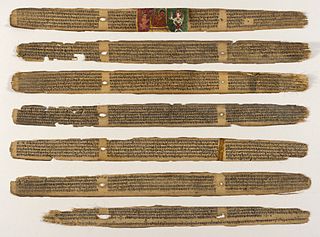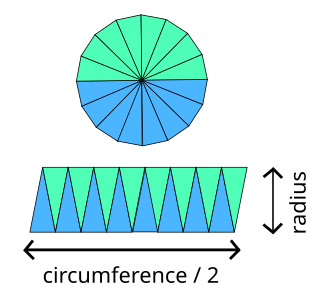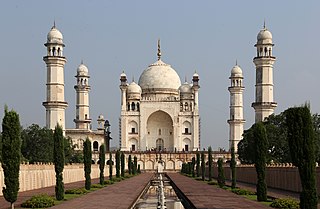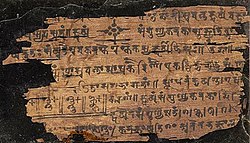Vāgbhaṭa (वाग्भट) was one of the most influential writers of Ayurveda. Several works are associated with his name as author, principally the Ashtāṅgasaṅgraha (अष्टाङ्गसंग्रह) and the Ashtāngahridayasaṃhitā (अष्टाङ्गहृदयसंहिता). The best current research, however, argues in detail that these two works cannot be the product of a single author. Indeed, the whole question of the relationship of these two works, and their authorship, is very difficult and still far from solution. Both works make frequent reference to the earlier classical works, the Charaka Samhita and the Sushruta Samhita. Vāgbhaṭa is said, in the closing verses of the Ashtāṅgasaṅgraha to have been the son of Simhagupta and pupil of Avalokita. His works mention worship of cattle and Brahmanas and various Hindu gods and goddesses, he also begins with a note on how Ayurveda evolved from Brahma and Sarasvati. His work contains syncretic elements.

The Bower Manuscript is a collection of seven fragmentary Buddhist Hybrid Sanskrit treatises found buried in a Buddhist memorial stupa near Kucha, northwestern China. Written in early Gupta script on birch bark, it is variously dated in 5th to early 6th century. The Bower manuscript includes the oldest dated fragments of an Indian medical text, the Navanitaka.
Nārāyaṇa Paṇḍita (1340–1400) was an Indian mathematician. Plofker writes that his texts were the most significant Sanskrit mathematics treatises after those of Bhaskara II, other than the Kerala school. He wrote the Ganita Kaumudi in 1356 about mathematical operations. The work anticipated many developments in combinatorics.
Indian mathematics emerged in the Indian subcontinent from 1200 BCE until the end of the 18th century. In the classical period of Indian mathematics, important contributions were made by scholars like Aryabhata, Brahmagupta, Bhaskara II, and Varāhamihira. The decimal number system in use today was first recorded in Indian mathematics. Indian mathematicians made early contributions to the study of the concept of zero as a number, negative numbers, arithmetic, and algebra. In addition, trigonometry was further advanced in India, and, in particular, the modern definitions of sine and cosine were developed there. These mathematical concepts were transmitted to the Middle East, China, and Europe and led to further developments that now form the foundations of many areas of mathematics.
The Hindu–Arabic numeral system is a decimal place-value numeral system that uses a zero glyph as in "205".
Śrīdhara or Śrīdharācārya was an Indian mathematician believed to come either from the Bengal region or from South India. Very little is known about his life beyond the content of his two extant treatises about arithmetic, Pāṭī-gaṇita and Tri-śatikā. He was mentioned by Bhāskara II, and made apparent reference to Brahmagupta. Govindasvāmin quoted a passage also found in Tri-śatikā, and overlapping material is found in the work of Mahāvīra, from which historians estimate Śrīdhara to have lived in the 8th or 9th century.

The Sushruta Samhita is an ancient Sanskrit text on medicine and surgery, and one of the most important such treatises on this subject to survive from the ancient world. The Compendium of Suśruta is one of the foundational texts of Ayurveda, alongside the Charaka-Saṃhitā, the Bhela-Saṃhitā, and the medical portions of the Bower Manuscript. It is one of the two foundational Hindu texts on the medical profession that have survived from ancient India.
Atreya (आत्रेय) Rishi, or Atreya Punarvasu, was a descendant of Atri, one of the great Hindu sages (rishis) whose accomplishments are detailed in the Puranas. Sage Atreya was a renowned scholar of Ayurveda, and a school of early Ayurveda was founded based on his teachings.
The Lokavibhāga is a Jain cosmological text originally composed in Prakrit by a Digambara monk, Sarvanandi, surviving in a later Sanskrit translation by one Siṃhasūri. It the oldest known Indian source to use zero as number. Surviving manuscripts of the Lokavibhāga are listed in v.26 of the New Catalogus Catalogorum. Parts of the Bakhshali Manuscript on arithmetic, which does use a physically written symbol for zero, have been carbon-dated, but the results of this dating are puzzling and are still being debated.

Siddhānta Śiromaṇi is the major treatise of Indian mathematician Bhāskara II. He wrote the Siddhānta Śiromaṇi in 1150 when he was 36 years old. The work is composed in Sanskrit Language in 1450 verses.
Kim Leslie Plofker is an American historian of mathematics, specializing in Indian mathematics.
Clemency Montelle is a New Zealand historian of mathematics known for her research on Indian mathematics and Indian astronomy. She is a professor of mathematics at the University of Canterbury, and a fellow of the New Zealand India Research Institute of the Victoria University of Wellington.
Mathematics in India: 500 BCE–1800 CE is a monograph about the history of Indian mathematics. It was written by American historian of mathematics Kim Plofker, and published in 2009 by the Princeton University Press. The Basic Library List Committee of the Mathematical Association of America has classified the book as essential for undergraduate mathematics libraries, their highest rating.

Gaṇeśa Daivajna was a sixteenth century astronomer, astrologer, and mathematician from western India who wrote books on methods to predict eclipses, planetary conjunctions, positions, and make calculations for calendars. His most major work was the Grahalaghava which was included ephemeris and calendar calculations.

'Ataullah Rushdi bin Ahmad Ma'mar was a 17th-century architect and a mathematics writer from the Mughal Empire of present-day India. He designed the Bibi Ka Maqbara at Aurangabad and some buildings at Shahjahanabad. As a mathematics writer, he translated the Arabic-language Khulasat al-Hisab and the Sanskrit-language Bijaganita into Persian.
Karana-kutuhala is a 1183 CE Sanskrit-language book on jyotisha by Bhaskara II, a mathematician-astronomer from present-day India.
Keshava was an astrologer and astronomer from Nandigrama in present-day western India.
Takao Hayashi is a Japanese mathematics educator, historian of mathematics specializing in Indian mathematics. Hayashi was born in Niigata, Japan. He obtained Bachelor of Science degree form Tohoku University, Sendai, Japan in 1974, Master of Arts degree from Tohuku University, Sendai, Japan in 1976 and a postgraduate degree from Kyoto University, Japan in 1979. He secured the Doctor of Philosophy degree from Brown University, USA in 1985 under the guidance of David Pingree. He was a researcher at Mehta Research Institute for Mathematics and Mathematical Physics, Allahabad, India during 1982–1983, a lecturer at Kyoto Women's College during 1985–1987. He joined Doshisha University, Kyoto as a lecturer in history of science in 1986 and was promoted as professor in 1995. He has also worked in various universities in Japan in different capacities.

Makarandasāriṇi is a Sanskrit astronomical table text composed by the Indian astronomer-mathematician Makaranda (c.1438-1478) hailing from Varanasi. In the Sanskrit astronomical literature such table texts are referred to as sāriṇi-s or koṣṭhaka-s. It is one of the most popular such texts ever composed in Sanskrit.

Mahādevī is a Sanskrit astronomical table text composed by the Indian astronomer-mathematician Mahādeva around the year 1316 CE. Since its composition, it has become the standard astronomical table among astronomers, astrologers and calendar makers in the Brāhma-pakṣa school. In view of the fact that more than a hundred manuscripts of the work have been unearthed, which is by far more numerous than the surviving manuscripts of any earlier koṣṭhaka, the word by which such table texts are referred to in Sanskrit, Mahādevī has been described as the "first 'canonical' koṣṭhaka". In the history of studies on Sanskrit astronomical table texts, Mahādevī was the first such text to be subjected to a systematic analysis using modern mathematical tools.









